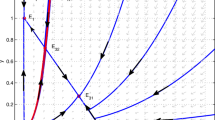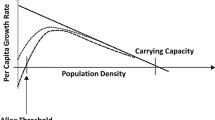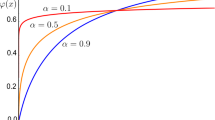Abstract
We propose a mathematical model for two species competing for a limited resource associated to polyhydroxyalkanoate (PHA) production, which possesses regime of stable states: stable equilibrium, and periodic and aperiodic oscillations. Such regimes of stable oscillations are absent in the model without taking into account PHA production but is known to exist in experimental model associated to the production of PHA. It explains the capacity of the system to sustain itself at the lowest value of resource. Thus, the proposed system provides a simpler four-dimensional model containing monod functions with such behaviours. Using analytical tools and numerical bifurcation analysis, we describe parameter regions and bifurcation structures leading to the existence and the coexistence between stable, unstable equilibrium and limit cycle. These explain critical parameter sensitivity impact on the process. Considering the effects on the proposed system under a frequent alternation of the input resource, we investigate how the increase of the length of the feast period in the Feast-Famine conditions, increases the PHA-production or decreases the lowest value of the resource at the equilibrium.
















Similar content being viewed by others
Data availability
The data from simulations that support the findings of this study are available on request from the corresponding author, B. I. Camara.
References
Steinbuchel, A.: Polyhydroxyalkanoic acids. In: Byrom, D. (ed.) Biomaterials: Novel Materials from Biological Sources, pp. 123–213. Stockton Press, New York (1991)
Tan, G.Y.A., Chen, C.L., Ge, L., Wang, L., Razaad, I.M.N., Li, Y., Zhao, L., Mo, Y., Wang, J.-Y.: Start a research on biopolymer polyhydroxyalkanoate (PHA): a review. Polymers 6, 706–754 (2014). https://doi.org/10.3390/polym6030706
Albuquerque, M.G.E., Torres, C.A.V., Reis, M.A.M.: Polyhydroxyalkanoate (PHA) production by a mixed microbial culture using sugar molasses: effect of the influent substrate concentration on culture selection. Water Res. 44, 3419–3433 (2010)
Mozumdera, M.S.I., Aminb, M.S.A., Shishira, M.F.R.: Unified model to predict and enhance the mixed culture polyhydroxyalkanoates (PHA) production. Bioresour. Technol. Rep. 11, 100537 (2020)
Huang, L., Chen, Z., Wen, Q., Zhao, L., Lee, D.-J., Yang, L., Wang, Y.: Insights into Feast-Famine polyhydroxyalkanoate (PHA)-producer selection: microbial community succession, relationships with system function and underlying forces. Water Res. 131, 167–176 (2018)
Sruamsiri, D., Thayanukul, P., Suwannasilp, B.B.: In situ identification of polyhydroxyalkanoate (PHA)-accumulating microorganisms in mixed microbial cultures under feast/famine conditions. Sci. Rep. 10, 3752 (2020). https://doi.org/10.1038/s41598-020-60727-7
Dias, J.M.L., Lemos, P.C., Serafim, L.S., Oliveira, C., Eiroa, M., Albuquerque, M.G.E., Ramos, A.M., Oliveira, R., Reis, M.A.M.: Recent advances in polyhydroxyalkanoate production by mixed aerobic cultures: from the substrate to the final product. Macromol. Biosci. 6, 885–906 (2006)
Moser, A.: Kinetics of batch fermentations. Biotechnology 2 (1985)
Mahanta, D., Borah, M., Saikia, P.: Study on kinetic models for analysing the bacterial growth rate. Am. Int. J. Res. Sci. Technol. Eng. Math. 8, 68–72 (2014)
Novak, M., Koller, M., Braunegg, G., Horvat, P.: Mathematical modelling as a tool for optimized PHA production. Chem. Biochem. Eng. Q. 29, 183–220 (2015)
Monod, J.: The growth of bacterial cultures. Rev. Microbiol. 3, 371–394 (1949)
Dhooge, A., Govaerts, W., Kuznetsov, Y.A.: MATCONT: a MATLAB package for numerical bifurcation analysis of ODEs. ACM Trans. Math. Softw. 29, 141–164 (2003)
Canavier, C.C., Baxter, D.A., Clark, J.W., Byrne, J.H.: Multiple modes of activity in a model neuron suggest a novel mechanism for the effects of neuromodulators. J. Neuro-physiol. 72, 872–882 (1994)
Tilman, D.: Resource competition between planktonic algae: an experimental and theoretical approach. Ecology 58, 338–348 (1977)
Tilman, D.: Resources: a graphical-mechanistic approach to competition and predation. Am. Nat. 116, 362–393 (1980)
Tilman, D., Mattson, M., Langer, S.: Competition and nutrient kinetics along a temperature gradient: an experimental test of a mechanistic approach to niche theory. Limnol. Oceanogr. 26(6), 1020–1033 (1981)
Tilman, D.: Resource Competition and Community Structure. Princeton University Press, Princeton (1982)
Tilman, D.: The Resource-Ratio Hypothesis of plant succession. Am. Nat. 125, 827–852 (1985)
Tilman, D., Lehman, C.L., Thomson, K.T.: Plant diversity and ecosystem productivity: theoretical considerations. Proc. Natl. Acad. Sci. USA 94, 1857–1861 (1997)
Daufresne, T., Hedin, L.O.: plant coexistence depends on ecosystem nutrient cycles: extension of the resource-ratio theory. PNAS (2005). https://doi.org/10.1073/pnas.0406427102
Jiang, Y., Hebly, M., Kleerebezem, R., Muyzer, G., Van Loosdrecht, M.: Metabolic modeling of mixed substrate uptake for polyhydroxyalkanoate (PHA) production. Water Res. 45, 1309–21 (2011)
Louca, S., Doebeli, M.: Transient dynamics of competitive exclusion in microbial communities. Environ. Microbiol. 18, 1863–1874 (2016)
Hardin, G.: The competitive exclusion principle. Science 131, 1292–1297 (1960)
Lehman, C.L., Tilman, D.: Biodiversity, stability, and productivity in competitive communities. Am. Nat. 156(5), 534–552 (2000)
**, Q., Roden, E.E., Giska, J.R.: Geomicrobial kinetics: extrapolating laboratory studies to natural environments. Geomicrobiol J 30, 173–185 (2013)
Hastings, A.: Transients: the key to long-term ecological understanding? Trends Ecol Evol 19, 39–45 (2004)
Bosi, S., Desmarchelier, D.: A simple method to study local bifurcations of three and four-dimensional systems: characterizations and economic applications. Documents de recherche 17-01, Centre d’Études des Politiques Économiques (EPEE), Université d’Evry Val d’Essonne (2017)
Chong, M.S., Shahrill, M., Crossley, L., Madzvamuse, A.: The stability analyses of the mathematical models of hepatitis c virus infection. Mod. Appl. Sci. 9(3), 250 (2015)
Enciso, G., Sontag, E.D.: On the stability of a model of testosterone dynamics. J. Math. Biol. 46(6), 627–634 (2004). https://doi.org/10.1007/s00285-004-0291-5
Touboula, J.D., Staverd, A.C., Levine, S.A.: On the complex dynamics of savanna landscapes. PNAS (2018). www.pnas.org/cgi/doi/10.1073/pnas.1712356115
Acknowledgements
The financial supports of this work have been EMS-Simons for Africa and Lorraine University, we are greatly thankful for their financial supports.
Author information
Authors and Affiliations
Corresponding author
Ethics declarations
Conflict of interest
The authors declare that they have no Conflict of interest.
Additional information
Publisher's Note
Springer Nature remains neutral with regard to jurisdictional claims in published maps and institutional affiliations.
Principal minors computation of the Jacobian matrix at model equilibria
Principal minors computation of the Jacobian matrix at model equilibria
For each equilibrium, the expressions of the elements of the Jacobian matrix and the principal minors are below:
-
(a)
\((N_P, N_O, R, PHA)^*\)=\((0, 0, R, 0)^*\)
$$\begin{aligned} A= & {} g_P\dfrac{R^*}{R^*+K_P}-m_P;\quad B=-Q_Pg_P\dfrac{R^*}{R^*+K_P};\\ C= & {} 0;\quad D=g_O\dfrac{R^*}{R^*+K_O}-m_O;\\ E= & {} -Q_Og_O\dfrac{R^*}{R^*+K_O};\quad F=0;\\ G= & {} 0;\quad H=-\alpha ; \\ I= & {} 0;\quad J=-m_{PHA}.\\ \end{aligned}$$
-
(b)
\((N_P, N_O, R, PHA)^*\)=\((0, N_O, R, 0)^*\)
$$\begin{aligned} A= & {} g_P\dfrac{R^*}{R^*+K_P}-m_P;\quad B=-Q_Pg_P\dfrac{R^*}{R^*+K_P};\\ C= & {} 0;\quad D=g_O\dfrac{R^*}{R^*+K_O}-m_O;\\ E= & {} -Q_Og_O\dfrac{R^*}{R^*+K_O};\quad F=0;\\ G= & {} N_O^*g_O\dfrac{K_O}{(R^*+K_O)^2};\quad H\\= & {} -\alpha -Q_Og_ON_O^*\dfrac{K_O}{(R^*+K_O)^2};\\ I= & {} 0;\quad J=-m_{PHA}.\\ \end{aligned}$$
-
(c)
\((N_P, N_O, R, PHA)^*\)=\((N_P, 0, R, 0)^*\)
$$\begin{aligned} A= & {} g_P\dfrac{R^*}{R^*+K_P}-m_P;\quad B=-Q_Pg_P\dfrac{R^*}{R^*+K_P};\\ C= & {} 0;\quad D=g_O\dfrac{R^*}{R^*+K_O}-m_O;\\ E= & {} -Q_Og_O\dfrac{R^*}{R^*+K_O}; \quad F=N_P^*g_P\dfrac{K_P}{(R^*+K_P)^2};\\ G= & {} 0;\quad H=-\alpha -Q_Pg_PN_P^*\dfrac{K_P}{(R^*+K_P)^2};\\ I= & {} \dfrac{bN_P^*}{K_{PHA}};\quad J=\dfrac{hN_P^*}{K_{PHA}}-m_{PHA}.\\ \end{aligned}$$
-
(d)
\((N_P, N_O, R, PHA)^*\)=\((N_P, 0, R, PHA)^*\)
$$\begin{aligned} A= & {} g_P\dfrac{R^*}{R^*+K_P}+b\dfrac{PHA^*}{PHA^*+K_{PHA}}-m_P;\quad B\\= & {} -Q_Pg_P\dfrac{R^*}{R^*+K_P};\\ C= & {} h\dfrac{PHA^*}{PHA^*+K_{PHA}};\quad D=g_O\dfrac{R^*}{R^*+K_O}-m_O;\\ E= & {} -Q_Og_O\dfrac{R^*}{R^*+K_O};\quad F=N_P^*g_P\dfrac{K_P}{(R^*+K_P)^2};\\ G= & {} 0;\quad H=-\alpha -Q_Pg_PN_P^*\dfrac{K_P}{(R^*+K_P)^2};\\ I= & {} bN_P^*\dfrac{K_{PHA}}{(PHA^*+K_{PHA})^2};\quad J\\= & {} hN_P^*\dfrac{K_{PHA}}{(PHA^*+K_{PHA})^2}-m_{PHA}.\\ \end{aligned}$$
-
(e)
\((N_P, N_O, R, PHA)^*\)=\((N_P, N_O, R, 0)^*\)
$$\begin{aligned} A= & {} g_P\dfrac{R^*}{R^*+K_P}-m_P;\quad B=-Q_Pg_P\dfrac{R^*}{R^*+K_P};\\ C= & {} 0;\quad D=g_O\dfrac{R^*}{R^*+K_O}-m_O;\\ E= & {} -Q_Og_O\dfrac{R^*}{R^*+K_O};\quad F=N_P^*g_P\dfrac{K_P}{(R^*+K_P)^2};\\ G= & {} N_O^*g_O\dfrac{K_O}{(R^*+K_O)^2};\quad H\\= & {} -\alpha -Q_Pg_PN_P^*\dfrac{K_P}{(R^*+K_P)^2}\\{} & {} -Q_Og_ON_O^*\dfrac{K_O}{(R^*+K_O)^2};\\ I= & {} \dfrac{bN_P^*}{K_{PHA}};\quad J=\dfrac{hN_P^*}{K_{PHA}}-m_{PHA}.\\ \end{aligned}$$
-
(f)
\((N_P, N_O, R, PHA)^*\)=\((N_P, N_O, R, PHA)^*\)
$$\begin{aligned} A= & {} g_P\dfrac{R^*}{R^*+K_P}+b\dfrac{PHA^*}{PHA^*+K_{PHA}}-m_P;\quad B\\= & {} -Q_Pg_P\dfrac{R^*}{R^*+K_P};\\ C= & {} h\dfrac{PHA^*}{PHA^*+K_{PHA}};\quad D=g_O\dfrac{R^*}{R^*+K_O}-m_O;\\ E= & {} -Q_Og_O\dfrac{R^*}{R^*+K_O};\quad F=N_P^*g_P\dfrac{K_P}{(R^*+K_P)^2};\\ G= & {} N_O^*g_O\dfrac{K_O}{(R^*+K_O)^2};\quad H\\= & {} -\alpha -Q_Pg_PN_P^*\dfrac{K_P}{(R^*+K_P)^2}\\{} & {} -Q_Og_ON_O^*\dfrac{K_O}{(R^*+K_O)^2};\\ I= & {} bN_P^*\dfrac{K_{PHA}}{(PHA^*+K_{PHA})^2};\quad J\\= & {} hN_P^*\dfrac{K_{PHA}}{(PHA^*+K_{PHA})^2}-m_{PHA}.\\ \end{aligned}$$
The characteristic polynomial versus the eigen value \(\lambda \) is given by:
where,
-
(i)
\((N_P, N_O, R, PHA)^*\)=\((0, 0, R, 0)^*\)
$$\begin{aligned} S_1= & {} A+D+H+J =T_r(J);\\ S_2= & {} \begin{vmatrix}H&0\\0&J\end{vmatrix} +\begin{vmatrix}D&0\\0&J\end{vmatrix}+\begin{vmatrix}D&0\\E&H\end{vmatrix}+\begin{vmatrix}A&0\\0&J\end{vmatrix}+\begin{vmatrix}A&0\\B&H\end{vmatrix}+\begin{vmatrix}A&0\\0&D\end{vmatrix};\\ {}= & {} HJ+DJ+DH+AJ+AH+AD;\\ S_3= & {} \begin{vmatrix}D&0&0\\E&H&0\\0&0&J\end{vmatrix}+\begin{vmatrix}A&0&0\\B&H&0\\0&0&J\end{vmatrix}+\begin{vmatrix}A&0&0\\0&D&0\\0&0&J\end{vmatrix}\\{} & {} +\begin{vmatrix}A&0&0\\0&D&0\\B&E&H\end{vmatrix}; \\ {}= & {} DHJ+AHJ+ADJ+ADH;\\ S_4= & {} \begin{vmatrix}A&0&0&0\\0&D&0&0\\B&E&H&0\\0&0&0&J\end{vmatrix}=AJDH=Det(J); \end{aligned}$$A, B, D, E, H, and J have the same expression as in 2.(a).
-
(ii)
\((N_P, N_O, R, PHA)^*\)=\((0, N_O, R, 0)^*\)
$$\begin{aligned} S_1= & {} A+D+H+J =T_r(J);\\ S_2= & {} \begin{vmatrix}H&0\\0&J\end{vmatrix} +\begin{vmatrix}D&0\\0&J\end{vmatrix}+\begin{vmatrix}D&G\\E&H\end{vmatrix}+\begin{vmatrix}A&0\\0&J\end{vmatrix}+\begin{vmatrix}A&0\\B&H\end{vmatrix}+\begin{vmatrix}A&0\\0&D\end{vmatrix};\\ {}= & {} HJ+DJ+DH-EG+AJ+AH+AD;\\ S_3= & {} \begin{vmatrix}D&G&0\\E&H&0\\0&0&J\end{vmatrix}+\begin{vmatrix}A&0&0\\B&H&0\\0&0&J\end{vmatrix}+\begin{vmatrix}A&0&0\\0&D&0\\0&0&J\end{vmatrix}\\{} & {} +\begin{vmatrix}A&0&0\\0&D&G\\B&E&H\end{vmatrix}; \\ {}= & {} DHJ-GEJ+AHJ+ADJ+ADH-AEG;\\ S_4= & {} \begin{vmatrix}A&0&0&0\\0&D&G&0\\B&E&H&0\\0&0&0&J\end{vmatrix}=AJ(DH-GE)=Det(J); \end{aligned}$$A, B, D, E, G, H, and J have the same expression as in 2.(b).
-
(iii)
\((N_P, N_O, R, PHA)^*\)=\((N_P, 0, R, 0)^*\)
$$\begin{aligned} S_1= & {} A+D+H+J =T_r(J);\\ S_2= & {} \begin{vmatrix}H&0\\0&J\end{vmatrix} +\begin{vmatrix}D&0\\0&J\end{vmatrix}+\begin{vmatrix}D&0\\E&H\end{vmatrix}+\begin{vmatrix}A&I\\0&J\end{vmatrix}+\begin{vmatrix}A&F\\B&H\end{vmatrix}+\begin{vmatrix}A&0\\0&D\end{vmatrix};\\ {}= & {} HJ+DJ+DH+AJ+AH-BF+AD;\\ S_3= & {} \begin{vmatrix}D&0&0\\E&H&0\\0&0&J\end{vmatrix}+\begin{vmatrix}A&F&I\\B&H&0\\0&0&J\end{vmatrix}+\begin{vmatrix}A&0&I\\0&D&0\\0&0&J\end{vmatrix}+\begin{vmatrix}A&0&F\\0&D&0\\B&E&H\end{vmatrix}; \\ {}= & {} DHJ+AHJ-FBJ+ADJ+ADH-FBD;\\ S_4= & {} \begin{vmatrix}A&0&F&I\\0&D&0&0\\B&E&H&0\\0&0&0&J\end{vmatrix}=AJDH-FDBJ=Det(J); \end{aligned}$$A, B, D, E, F, H, I, and J have the same expression as in 2.(c).
-
(iv)
\((N_P, N_O, R, PHA)^*\)=\((N_P, 0, R, PHA)^*\)
$$\begin{aligned} S_1= & {} A+D+H+J =T_r(J);\\ S_2= & {} \begin{vmatrix}H&0\\0&J\end{vmatrix} +\begin{vmatrix}D&0\\0&J\end{vmatrix}+\begin{vmatrix}D&0\\E&H\end{vmatrix}+\begin{vmatrix}A&I\\C&J\end{vmatrix}+\begin{vmatrix}A&F\\B&H\end{vmatrix}+\begin{vmatrix}A&0\\0&D\end{vmatrix};\\ {}= & {} HJ+DJ+DH+AJ-CI+AH-BF+AD;\\ S_3= & {} \begin{vmatrix}D&0&0\\E&H&0\\0&0&J\end{vmatrix}+\begin{vmatrix}A&F&I\\B&H&0\\C&0&J\end{vmatrix}+\begin{vmatrix}A&0&I\\0&D&0\\C&0&J\end{vmatrix}+\begin{vmatrix}A&0&F\\0&D&0\\B&E&H\end{vmatrix}; \\ {}= & {} DHJ+AHJ-FBJ-ICH+ADJ-ICD\\ {}{} & {} +ADH-FBD;\\ S_4= & {} \begin{vmatrix}A&0&F&I\\0&D&0&0\\B&E&H&0\\C&0&0&J\end{vmatrix}=AJDH-FDBJ-ICDH=Det(J); \end{aligned}$$A, B, C, D, E, F, H, I, and J have the same expression as in 2.(d).
-
(v)
\((N_P, N_O, R, PHA)^*\)=\((N_P, N_O, R, 0)^*\)
$$\begin{aligned} S_1= & {} A+D+H+J =T_r(J);\\ S_2= & {} \begin{vmatrix}H&0\\0&J\end{vmatrix} +\begin{vmatrix}D&0\\0&J\end{vmatrix}+\begin{vmatrix}D&G\\E&H\end{vmatrix}+\begin{vmatrix}A&I\\C&J\end{vmatrix}+\begin{vmatrix}A&F\\B&H\end{vmatrix}+\begin{vmatrix}A&0\\0&D\end{vmatrix};\\ {}= & {} HJ+DJ+DH-EG+AJ-CI+AH-BF+AD;\\ S_3= & {} \begin{vmatrix}D&G&0\\E&H&0\\0&0&J\end{vmatrix}+\begin{vmatrix}A&F&I\\B&H&0\\C&0&J\end{vmatrix}+\begin{vmatrix}A&0&I\\0&D&0\\C&0&J\end{vmatrix}+\begin{vmatrix}A&0&F\\0&D&G\\B&E&H\end{vmatrix};\\= & {} DHJ-GEJ+AHJ-FBJ-ICH+ADJ\\ {}{} & {} -ICD+ADH-AEG-FBD;\\ S_4= & {} \begin{vmatrix}A&0&F&I\\0&D&G&0\\B&E&H&0\\C&0&0&J\end{vmatrix}\\= & {} AJ(DH-GE)-FDBJ-IC(DH-GE)=Det(J); \end{aligned}$$A, B, D, E, F, G, H, I, and J have the same expression as in 2.(e).
-
(vi)
\((N_P, N_O, R, PHA)^*\)=\((N_P, N_O, R, PHA)^*\)
$$\begin{aligned} S_1= & {} A+D+H+J =T_r(J);\\ S_2= & {} \begin{vmatrix}H&0\\0&J\end{vmatrix} +\begin{vmatrix}D&0\\0&J\end{vmatrix}+\begin{vmatrix}D&G\\E&H\end{vmatrix}+\begin{vmatrix}A&I\\0&J\end{vmatrix}+\begin{vmatrix}A&F\\B&H\end{vmatrix}+\begin{vmatrix}A&0\\0&D\end{vmatrix};\\ {}= & {} HJ+DJ+DH-EG+AJ+AH-BF+AD;\\ S_3= & {} \begin{vmatrix}D&G&0\\E&H&0\\0&0&J\end{vmatrix}+\begin{vmatrix}A&F&I\\B&H&0\\0&0&J\end{vmatrix}+\begin{vmatrix}A&0&I\\0&D&0\\0&0&J\end{vmatrix}+\begin{vmatrix}A&0&F\\0&D&G\\B&E&H\end{vmatrix}; \\ {}= & {} DHJ-GEJ+AHJ-FBJ+ADJ\\ {}{} & {} +ADH-AEG-FBD;\\ S_4= & {} \begin{vmatrix}A&0&F&I\\0&D&G&0\\B&E&H&0\\0&0&0&J\end{vmatrix}\\= & {} AJ(DH-GE)-FDBJ=Det(J); \end{aligned}$$A, B, C, D, E, F, G, H, I, and J have the same expression as in 2.(f).
Rights and permissions
Springer Nature or its licensor (e.g. a society or other partner) holds exclusive rights to this article under a publishing agreement with the author(s) or other rightsholder(s); author self-archiving of the accepted manuscript version of this article is solely governed by the terms of such publishing agreement and applicable law.
About this article
Cite this article
Tagne Nkounga, I.B., Bauda, P., Yamapi, R. et al. Self-sustained dynamics by modeling competing PHA-producers and non-PHA-producers bacteria population for a limited resource: local and homoclinic bifurcation analysis. Nonlinear Dyn 112, 9673–9701 (2024). https://doi.org/10.1007/s11071-024-09541-8
Received:
Accepted:
Published:
Issue Date:
DOI: https://doi.org/10.1007/s11071-024-09541-8




